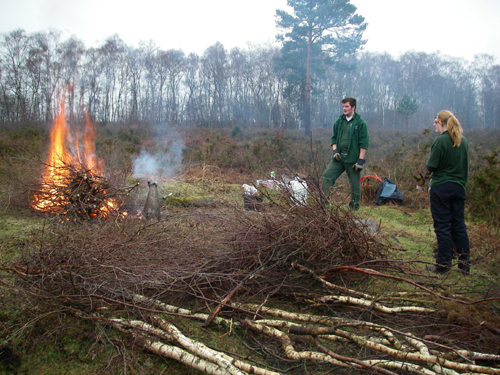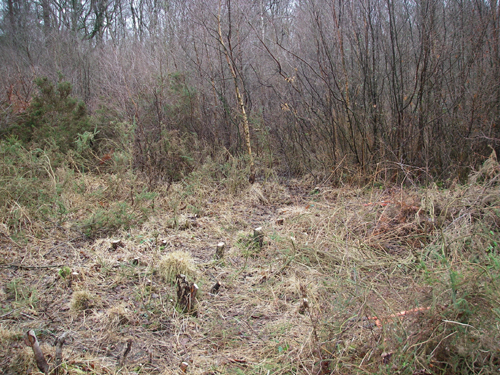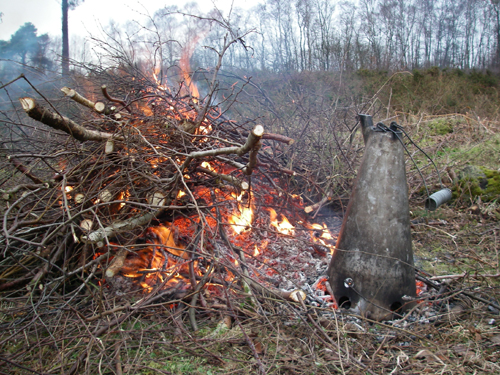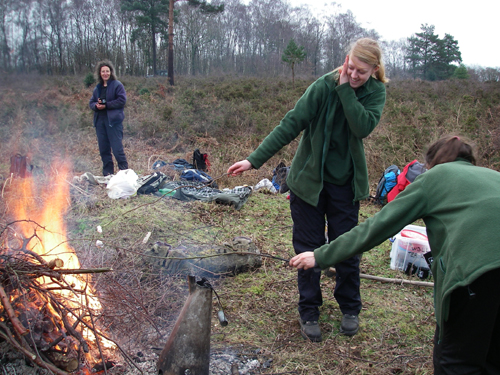Wednesday was the weekly volunteer conservation task up at Greenham Common, and a welcome break for me from filling out grant applications and website building. The midweek group carries out practical tasks and wildlife surveys at various sites including Greenham and Crookham Commons, Bowdown Nature Reserve and Thatcham Reedbeds. These all fall into a larger area designated as the West Berkshire Living Landscape project, a conservation initiative run jointly by BBOWT and West Berkshire Countryside Service to improve wildlife habitats and promote involvement and appreciation by local people.
This week we were at Brackenhurst (an area on the south side of Greenham Common), which is also one of the sites that I help survey for reptiles. We were clearing birch scrub from a wet valley bog (or mire) that runs down to the woodland edge there, to enable it to remain as an open wet habitat rather than getting taken over by trees and drying out. A lot of practical conservation in the UK consists of this sort of thing – halting the natural development (or succession, as it’s known) of open habitats like heathlands, marsh and grasslands, because for most areas in Britain the natural state would be woodland. It might seem a funny sort of way to help the environment – cutting down trees – but heathlands such as Greenham cannot be managed as open habitats by grazing alone, and without this kind of intervention most areas would ‘scrub up’ and become woodland… With a consequent loss of wildlife species associated with open habitats.
Plants that are found in these damp valley bogs include Sphagnum mosses, Sundews (Drosera species, carnivorous plants), Cross-leaved Heath Erica tetralix and Bog asphodel Narthecium ossifragum. They are also valuable to animals such as dragonflies, Bog Bush cricket Metrioptera bracyptera, and reptiles and amphibians including Grass snakes Natrix natrix and newt species. It being only January, there wasn’t much wildlife in evidence to be photographed: a Buzzard Buteo buteo flew over, whistling loudly, but lacking a zoom lens my photo of it wasn’t worth posting here – unless you have a good imagination!
Usually we stack some of the cut scrub to make habitat piles that will be used by small mammals, insects and other animals: we also burn some of it, which has the pleasant side benefit of boiling our storm kettle for tea breaks, the mainstay of all voluntary conservation work. We still had some munchables left over from our Christmas barbecue, so everyone tucked into gingerbread men and biccies whilst finding time to admire items of protective clothing, such as Mike’s kneepads!
Ade (West Berkshire Ranger) and Roger (BBOWT Living Landscape Project Officer) who usually manage the Wednesday work parties were both busy elsewhere
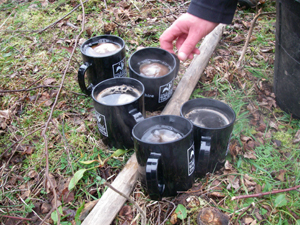 this week, so under the capable supervision of four BBOWT trainees we cleared a considerable amount of scrub, with a midway lunch break featuring (of course) more tea and biscuits. Conservation can be quite hard physical work, so it’s always heartening when task leaders understand the importance of keeping their volunteers’ caffeine and blood sugar levels regularly topped up! A process that was further aided by the discovery of a bag of marshmallows (also left over from our Christmas bash).
this week, so under the capable supervision of four BBOWT trainees we cleared a considerable amount of scrub, with a midway lunch break featuring (of course) more tea and biscuits. Conservation can be quite hard physical work, so it’s always heartening when task leaders understand the importance of keeping their volunteers’ caffeine and blood sugar levels regularly topped up! A process that was further aided by the discovery of a bag of marshmallows (also left over from our Christmas bash). 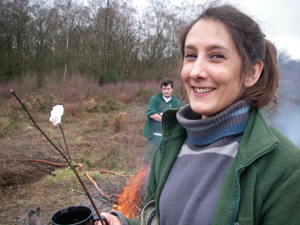 Toasting sticks were deftly whittled into shape, and soon people were tucking into smoking caramelised treats with only a few minor tongue burns (approximate core temperature of toasted marshmallows being slightly less than the centre of the Sun).
Toasting sticks were deftly whittled into shape, and soon people were tucking into smoking caramelised treats with only a few minor tongue burns (approximate core temperature of toasted marshmallows being slightly less than the centre of the Sun).
These Wednesday volunteering sessions are always enjoyable, whatever the weather, and the people who come are friendly and often very knowledgeable about local wildlife. Anyone can join and all tools and protective kit (work gloves etc) are provided, you just need to bring a packed lunch if you’re staying for the whole day. Ade or Roger are the folks to get in touch with to find out more – see my links to West Berkshire Countryside Service or BBOWT at the start of this blog entry.

